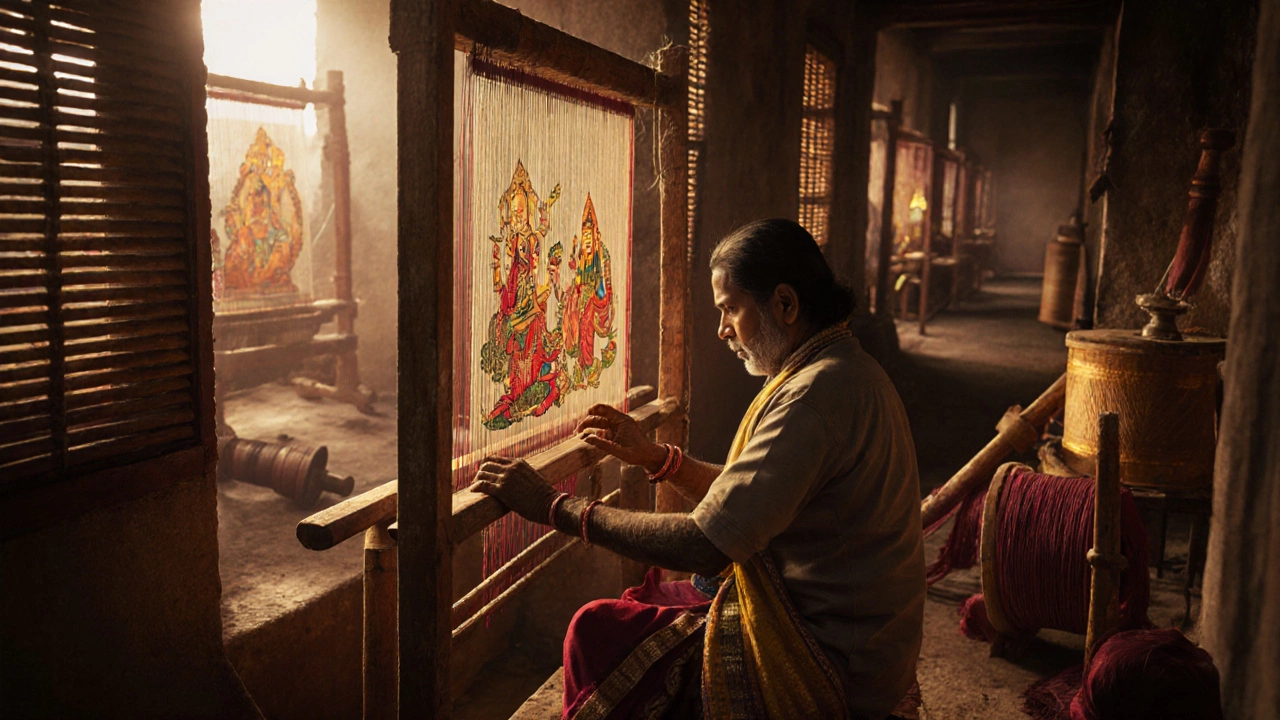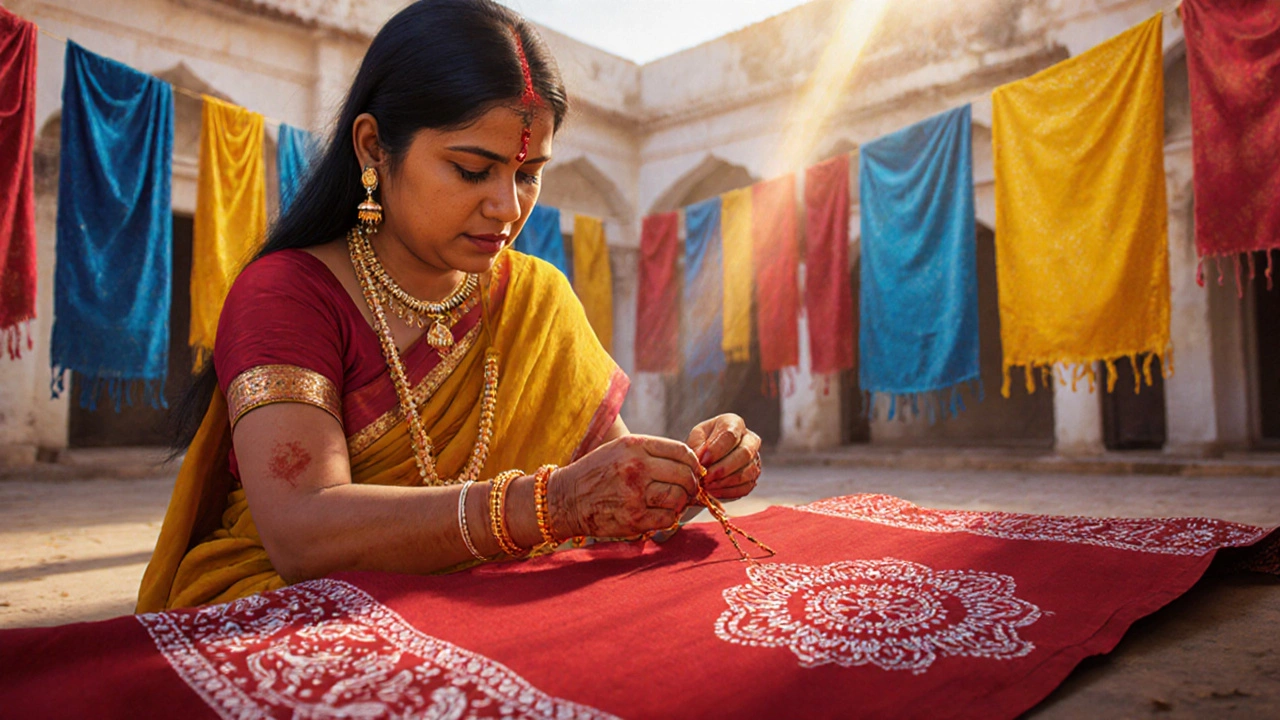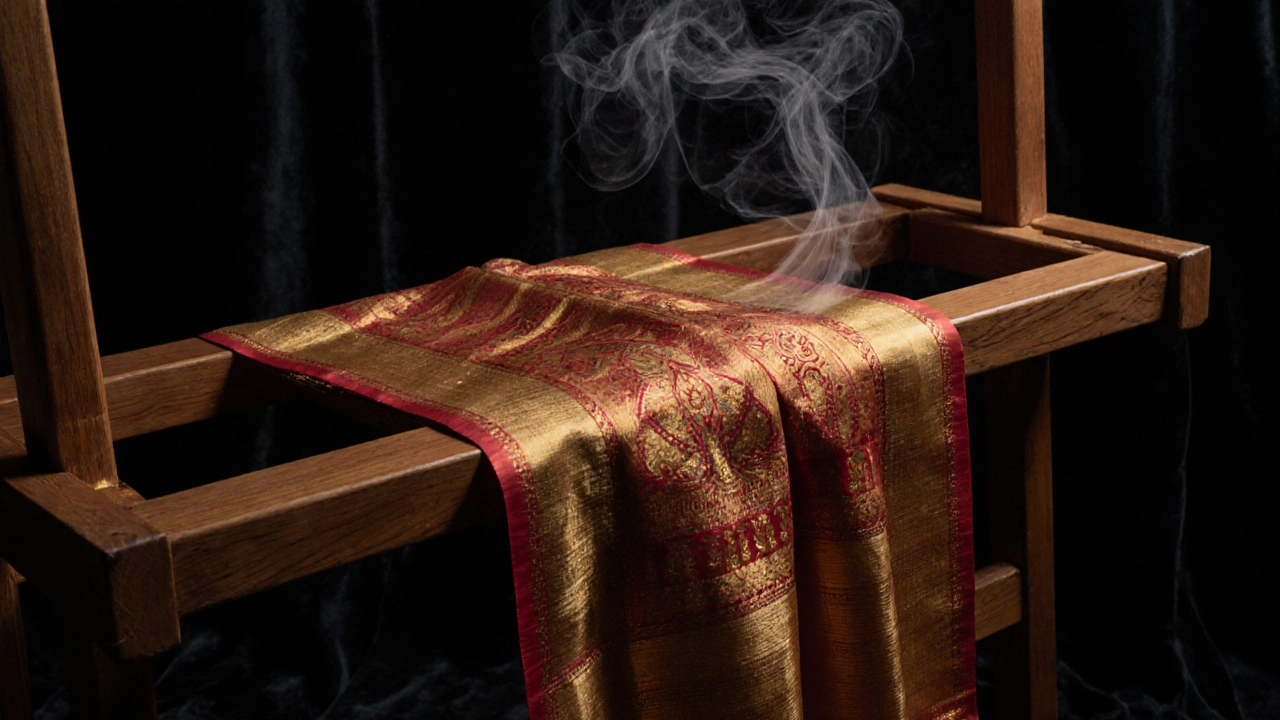
Indian Textile Region Quiz
Discover which Indian state is famous for what fabric. Answer 5 questions to see your score!
Question will appear here
Score: 0
When you think of Indian fabric, you don’t just think of cloth-you think of color, craft, and centuries of tradition. But not every state in India makes the same kind of fabric. Some regions are known for silk so fine it glides like water. Others weave cotton so soft it feels like a breath. And then there are places where every household has a loom, and weaving isn’t just a job-it’s identity.
West Bengal: The Heart of Handloom
West Bengal doesn’t just make fabric-it preserves it. The state is home to the handloom industry that supplies over 40% of India’s handwoven textiles. In districts like Murshidabad and Birbhum, you’ll find weavers using centuries-old pit looms to create Baluchari and Tant sarees. Baluchari silk sarees, with their intricate mythological motifs, are so detailed they take up to three months to finish. Tant cotton, on the other hand, is lightweight and breathable, perfect for India’s humid climate. These aren’t mass-produced items. Each piece is signed by the weaver, and many families have passed down their patterns for five generations.
Gujarat: Where Bandhani Meets Heritage
If you’ve ever seen a saree covered in tiny dots of color, you’ve seen Bandhani from Gujarat. This tie-dye technique is so deeply rooted here that entire villages in Bhuj, Jamnagar, and Surat specialize in it. The process? Threads are tied into minuscule knots before dyeing, creating patterns that look like constellations. Bandhani isn’t just decorative-it’s cultural. Brides in western India still wear Bandhani sarees as a symbol of joy and fertility. The state also leads in printed cotton fabrics, especially from the Kutch region, where natural dyes from indigo, pomegranate, and turmeric are still used. Over 150,000 artisans in Gujarat depend on this craft, and many of them are women who work from home.
Tamil Nadu: The Powerhouse of Powerloom
Tamil Nadu doesn’t just make fabric-it moves it. The state produces nearly 30% of India’s total textile output, with Coimbatore and Erode as its textile engines. Here, powerlooms churn out millions of meters of cotton daily. But don’t mistake this for soulless production. Tamil Nadu’s Kanchipuram silk is world-famous. These sarees use pure mulberry silk and real gold zari (thread), making them heavy, shimmering, and expensive. A single Kanchipuram saree can cost anywhere from ₹15,000 to over ₹1 lakh. What makes them special? The density of the weave-up to 1,200 threads per inch-and the fact that each saree is woven on a traditional jacquard loom. The state also exports over $1.2 billion in textiles annually, mostly to the US, UK, and UAE.

Uttar Pradesh: The Silk Capital of India
Varanasi, also known as Banaras, is where silk becomes sacred. The city has been weaving Banarasi silk for over 400 years. These sarees and dupattas are woven with gold and silver threads, often featuring floral and paisley motifs inspired by Mughal art. Unlike other silks, Banarasi silk is dense, stiff, and meant to last. It’s not worn for casual occasions-it’s worn for weddings, festivals, and religious ceremonies. The city has over 20,000 weavers, many working in small family units. The government has even granted Banarasi silk a Geographical Indication (GI) tag, meaning only silk woven in this region can legally be called Banarasi. A single saree can take 15 to 45 days to complete, depending on the complexity.
Andhra Pradesh and Telangana: The Kalamkari and Pochampally Legacy
In the southern districts of Andhra Pradesh, you’ll find Kalamkari-fabric painted by hand using natural dyes and bamboo pens. The word means “pen work,” and the designs often depict Hindu epics like the Ramayana. The process takes weeks: the cloth is washed 17 times, soaked in milk and myrobalan, then dyed with plant-based colors. Meanwhile, in Telangana’s Pochampally village, the Ikat technique rules. Here, threads are tie-dyed before weaving, creating blurred, dreamlike patterns. Pochampally Ikat received its own GI tag in 2005. Both crafts are dying out due to cheap machine-made imports, but NGOs and cooperatives are now working to revive them with fair wages and direct sales to global markets.
Maharashtra: The Surat Factor
Surat may not be known for handlooms, but it’s the beating heart of India’s synthetic textile industry. Over 90% of India’s polyester and blended fabrics are processed here. Surat’s mills produce everything from glittery bridal fabrics to affordable dupattas sold in markets across Asia and Africa. The city’s real strength? Speed and scale. A single factory can produce 10,000 meters of fabric in a day. Surat also leads in zari production-over 80% of India’s metallic thread comes from here. But behind the numbers are real challenges: water pollution, worker health issues, and pressure to cut costs. Still, the city’s textile market, the largest in Asia, moves $15 billion worth of fabric every year.

Why It Matters: Beyond the Fabric
When you buy fabric from one of these states, you’re not just buying cloth. You’re supporting livelihoods. In West Bengal, a weaver’s monthly income can rise from ₹8,000 to ₹25,000 when selling directly through cooperatives. In Tamil Nadu, young women are learning to operate computerized looms, blending tradition with tech. In Gujarat, women’s self-help groups now control 60% of the Bandhani supply chain. These aren’t just industries-they’re ecosystems of culture, skill, and resilience.
Global brands like Anthropologie, Zara, and even luxury labels like Gucci source fabrics from these regions. But most consumers don’t know where their saree or scarf came from. Learning which state makes what fabric helps you make smarter choices-whether you’re buying for yourself, gifting, or supporting ethical fashion.
What to Look For When Buying Indian Fabric
- Check for GI tags-they guarantee authenticity. Banarasi silk, Pochampally Ikat, and Kanchipuram silk all have them.
- Feel the weight-true Kanchipuram silk is heavy. Tant cotton is light and airy.
- Look for imperfections-handwoven fabrics have slight variations. Perfect symmetry often means machine-made.
- Ask about dyes-natural dyes smell earthy. Chemical dyes smell sharp or plastic-like.
- Buy from cooperatives-organizations like FabIndia, Dastkar, and Sutra help artisans get fair prices.
Which state in India is famous for silk fabric?
Uttar Pradesh, especially Varanasi, is the most famous for silk fabric in India. Banarasi silk, known for its heavy gold and silver zari work, is considered the finest silk saree in the country. Tamil Nadu’s Kanchipuram silk is another top contender, prized for its density and durability. Both have Geographical Indication (GI) protection.
What is the most popular cotton fabric in India?
Tant cotton from West Bengal is the most popular for everyday wear. It’s lightweight, breathable, and affordable. But Gujarat and Maharashtra also produce large volumes of printed and blended cotton. In southern states like Tamil Nadu and Andhra Pradesh, fine, hand-spun Khadi cotton is gaining popularity for its sustainability.
Is Kanchipuram silk only from Tamil Nadu?
Yes. Kanchipuram silk is exclusively woven in Kanchipuram and surrounding areas in Tamil Nadu. The silk is sourced from Karnataka, but the weaving technique, thread density, and zari work are unique to this region. It has a GI tag that legally protects its origin.
Which state makes the most fabric in India?
Tamil Nadu produces the most fabric in India by volume, contributing nearly 30% of the country’s total textile output. It leads in both powerloom cotton and handwoven silk. However, Gujarat and Maharashtra dominate in synthetic and blended fabrics, making them top exporters.
Are handloom fabrics more expensive than machine-made ones?
Yes, handloom fabrics are typically 3 to 10 times more expensive than machine-made ones. That’s because they take days or weeks to make, use traditional techniques, and support skilled artisans. But the quality, uniqueness, and cultural value justify the price. A handwoven Banarasi saree can last decades, while a machine-made version may fray after a few washes.
Can I buy authentic Indian fabric online?
Yes, but be careful. Look for platforms that work directly with weaver cooperatives-like FabIndia, Sutra, Dastkar, or Craftsvilla. Avoid marketplaces that list "Banarasi silk" but sell synthetic blends. Check for GI tags, real photos of weavers at work, and detailed descriptions of the weaving process.
Where to Go Next
If you’re fascinated by Indian fabric, explore how these traditions are being revived through digital platforms. Some weavers now livestream their looms on Instagram. Others use QR codes on sarees that take you to the artisan’s story. The future of Indian textiles isn’t just in preservation-it’s in innovation. And if you ever visit India, don’t just shop. Talk to the weaver. Ask them how long it took. Listen to their story. That’s where the real fabric lies-not in the thread, but in the hands that made it.

